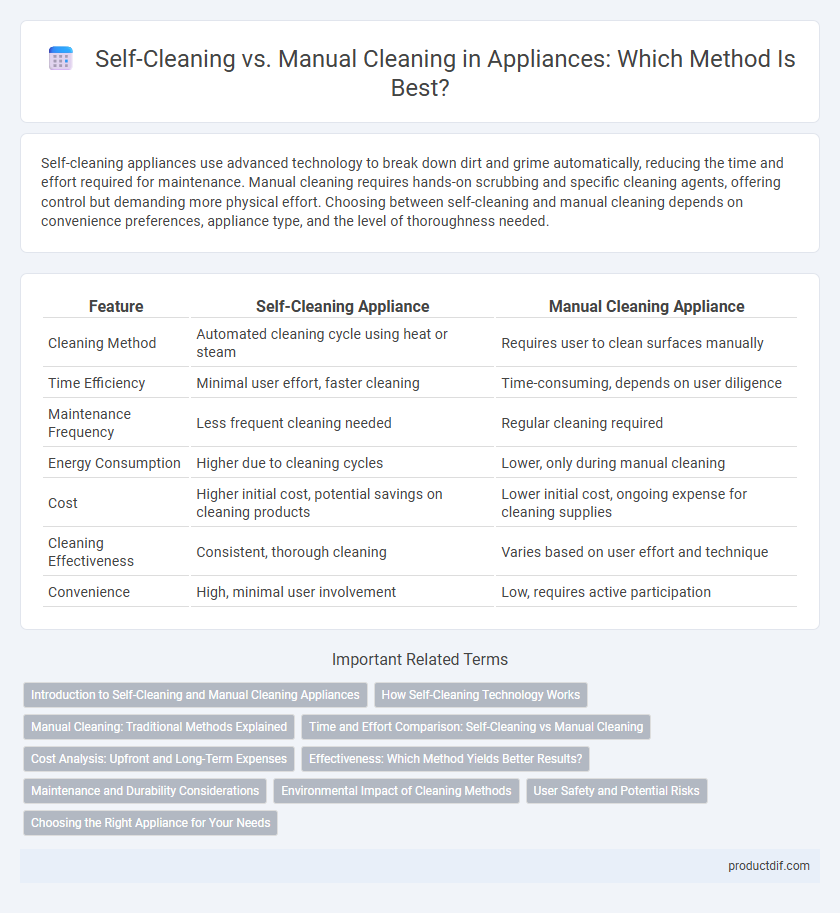Self-cleaning appliances use advanced technology to break down dirt and grime automatically, reducing the time and effort required for maintenance. Manual cleaning requires hands-on scrubbing and specific cleaning agents, offering control but demanding more physical effort. Choosing between self-cleaning and manual cleaning depends on convenience preferences, appliance type, and the level of thoroughness needed.
Table of Comparison
| Feature | Self-Cleaning Appliance | Manual Cleaning Appliance |
|---|---|---|
| Cleaning Method | Automated cleaning cycle using heat or steam | Requires user to clean surfaces manually |
| Time Efficiency | Minimal user effort, faster cleaning | Time-consuming, depends on user diligence |
| Maintenance Frequency | Less frequent cleaning needed | Regular cleaning required |
| Energy Consumption | Higher due to cleaning cycles | Lower, only during manual cleaning |
| Cost | Higher initial cost, potential savings on cleaning products | Lower initial cost, ongoing expense for cleaning supplies |
| Cleaning Effectiveness | Consistent, thorough cleaning | Varies based on user effort and technique |
| Convenience | High, minimal user involvement | Low, requires active participation |
Introduction to Self-Cleaning and Manual Cleaning Appliances
Self-cleaning appliances, such as ovens and washing machines, use advanced technology like high-temperature cycles or steam to eliminate dirt and grime without manual scrubbing. Manual cleaning appliances require user intervention through physical wiping, brushing, or detergent application to maintain cleanliness. Choosing between self-cleaning and manual cleaning devices impacts maintenance time, energy consumption, and appliance longevity.
How Self-Cleaning Technology Works
Self-cleaning technology in appliances uses high temperatures or steam to break down food residues and grease, eliminating the need for scrubbing. Pyrolytic ovens, for example, reach temperatures up to 900degF to incinerate spills into ash, which can be easily wiped away. This automated process reduces cleaning time and maintains appliance hygiene more effectively compared to manual methods.
Manual Cleaning: Traditional Methods Explained
Manual cleaning of appliances involves using basic tools like cloths, sponges, and mild detergents to remove dirt, grease, and grime. This traditional method relies on physical effort and consistent maintenance, making it effective for hard-to-reach areas that self-cleaning features might miss. Common manual cleaning techniques include scrubbing stovetop burners, wiping refrigerator shelves, and descaling coffee makers to ensure appliance longevity and hygiene.
Time and Effort Comparison: Self-Cleaning vs Manual Cleaning
Self-cleaning appliances reduce the time spent on maintenance by automating the cleaning process, often completing cycles in under an hour, whereas manual cleaning requires extensive hands-on effort and can take several hours depending on the appliance type. Automated self-cleaning technology minimizes physical labor and the need for harsh chemicals, improving user convenience. In contrast, manual cleaning demands consistent attention, scrubbing, and drying, which increases overall effort and time investment.
Cost Analysis: Upfront and Long-Term Expenses
Self-cleaning appliances typically involve higher upfront costs due to advanced technology and specialized materials, while manual cleaning models are generally more affordable at purchase. Over the long term, self-cleaning appliances can reduce expenses by minimizing the need for cleaning supplies and labor, but may incur higher maintenance or repair costs. Evaluating total cost of ownership requires balancing initial investment against savings in time, effort, and consumables over the appliance's lifespan.
Effectiveness: Which Method Yields Better Results?
Self-cleaning ovens utilize high temperatures or steam to effectively break down grease and food residue, often achieving deeper cleanliness with less effort than manual scrubbing. Manual cleaning allows targeted attention to stubborn spots but can be time-consuming and may miss hard-to-reach areas compared to automatic cycles. Studies show self-cleaning functions reduce bacteria and grime more consistently, enhancing appliance longevity and hygiene.
Maintenance and Durability Considerations
Self-cleaning appliances reduce maintenance efforts by utilizing high temperatures or chemical processes to eliminate residues, extending the lifespan of components through less frequent manual intervention. Manual cleaning enables detailed inspection and immediate removal of stubborn grime, but may increase wear over time due to abrasive scrubbing and inconsistent cleaning intervals. Choosing between self-cleaning and manual cleaning impacts appliance durability, with self-cleaning offering consistent upkeep while manual methods demand regular, careful maintenance to prevent long-term damage.
Environmental Impact of Cleaning Methods
Self-cleaning appliances significantly reduce water and chemical detergent usage compared to manual cleaning, lowering environmental pollution and conserving natural resources. Manual cleaning often involves harsh chemicals that can harm ecosystems when improperly disposed of, increasing the carbon footprint associated with household maintenance. Energy-efficient self-cleaning systems further minimize electricity consumption, supporting sustainability goals while maintaining appliance hygiene.
User Safety and Potential Risks
Self-cleaning appliances reduce user exposure to harsh chemicals and high-temperature cleaning cycles, minimizing the risk of burns or respiratory irritation. Manual cleaning requires handling detergents and scrubbing surfaces, increasing the likelihood of skin contact with irritants and accidental injury. Choosing self-cleaning options enhances user safety by limiting direct interaction with hazardous cleaning agents and reducing potential accidents.
Choosing the Right Appliance for Your Needs
Selecting the right appliance depends on the balance between convenience and thoroughness, where self-cleaning models offer automatic cycle options that save time and reduce manual effort. Manual cleaning appliances typically provide more control over cleaning intensity and maintenance, ideal for users who prioritize detailed care or cost-effectiveness. Evaluate factors such as frequency of use, desired cleanliness level, and budget to determine whether a self-cleaning or manual cleaning appliance best suits your lifestyle.
Self-Cleaning vs Manual Cleaning Infographic

 productdif.com
productdif.com